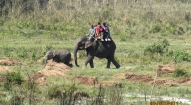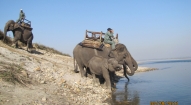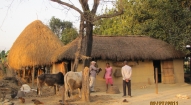- Home |
- Why With Us |
- About Us |
- Booking |
- Contact Us |
- Site Map


Chitwan National Park
Days from
The former hunting grounds of the erstwhile rulers of the country, Chitwan National Park in south central Nepal was declared a UNESCO World Heritage Site in 1979. The park covers an area of 932 sq km and is home to the Royal Bengal Tiger and the One horned Rhinoceros among the 50 or so mammals, 526 birds and 49 amphibians reptiles. The Naryani and Rapti rivers provide habitat to the endangered Snouted Gharial, Marsh Mugger and the Gangetic Dolphin. The bird population includes the likes of the Paradise Flycatcher, Indian Pitta and parakeets and migratory birds like the Brahminy Duck, Pintail, Bar-headed Geese, Cormorants and other feathered friends from Siberia. The Tharu people who are an indigenous ethnic community who live around the park collect the tall Elephant grass for use during late winter and early spring.
| Coordinates : 27°30′0″N84°20′0″E | Area : 932 km² |
| Best Season : Oct -Feb | Nearest Town : Bharatpur |
| Nearest Airport : Bhairawa | Established : 1973 |
The former hunting grounds of the erstwhile rulers of the country, Chitwan National Park in south central Nepal was declared a UNESCO World Heritage Site in 1979. The park covers an area of 932 sq km and is home to the Royal Bengal Tiger and the One horned Rhinoceros among the 50 or so mammals, 526 birds and 49 amphibians reptiles. The Naryani and Rapti rivers provide habitat to the endangered Snouted Gharial, Marsh Mugger and the Gangetic Dolphin. The bird population includes the likes of the Paradise Flycatcher, Indian Pitta and parakeets and migratory birds like the Brahminy Duck, Pintail, Bar-headed Geese, Cormorants and other feathered friends from Siberia. The Tharu people who are an indigenous ethnic community who live around the park collect the tall Elephant grass for use during late winter and early spring.
Chitwan is five hours drive from Kathmandu. An old runway strip in Meghauli is also used for charter flights. There are seven world class safari lodges inside the park and numerous other hotels and lodges outside the park. Visitors to the park are taken on jungle safaris on elephant back, jeeps and nature walks as well as boat rides in the Narayani and Rapti rivers. The park headquarters at Kasara is 21Km from Bharatpur which is 20 minutes by air or 146 km by road from Kathmandu. The best seasons to visit the park are from October to February when it's not too hot.
Features
The park consists of a diversity of ecosystems-including the Churia hills, Ox-bow lakes, and the flood plains of the Rapti, Reu and Narayani Rivers. The Churia hills rise slowly towards the east from 150 m. to more than 800 m. The western portion of the park is comprised of the lower but more rugged Someshwor hill. The park shares its eastern boundary with the Parsa Wildlife Reserve.
Mammals
The Chitwan National Park is home to at least 43 species of mammals including Royal Bengal Tiger, Leopards, fishing cats, jungle cats, clouded leopards, leopard cats, marbled cats, golden jackals, Indian wild dogs, sloth bears, Bengal foxes, Spotted linsangs, palm civets, Large and Small Indian civets, several species of mongoose, binturongs, honey badgers and yellow-throated martens roam the jungle for prey. Striped hyenas are rare and prevail on the southern slopes of the Churia Hills. Smooth-coated otters inhabit the numerous creeks and rivulets. Since 1973 the population has recovered well and increased to 544 animals around the turn of the century. The Chitwan population of the world's largest wild cattle species has increased from 188 to 296 animals in the years 1997 to 2007. In addition, numerous wild boars, sambar deer, Indian muntjac, hog deer and herds of chital inhabit the park. Four-horned antelopes reside predominantly in the hills. Furthermore rhesus monkeys, hanuman langurs, Indian pangolins, Indian porcupines, several species of flying squirrels, black-naped hares and endangered hispid hares are present.
Birds
Every year dedicated bird watchers and conservationists survey bird species occurring all over the country. In 2006 they recorded 543 species in the Chitwan National Park, much more than in any other protected area in Nepal and about two-thirds of Nepal's globally threatened species.
Especially the park’s alluvial grasslands are important habitats for the critically endangered Bengal florican, the vulnerable lesser adjutant, grey-crowned prinia, swamp francolin and several species of grass warblers. The near threatened Oriental darter is a resident breeder around the many lakes, where also egrets, bitterns, storks and kingfisher abound. The park is one of the few known breeding sites of the globally threatened Indian spotted eagle. Apart from the resident birds about 160 migrating and vagrant species arrive in Chitwan in autumn from northern latitudes to spend the winter here, among them are the Greater Spotted Eagle, Eastern Imperial Eagle and Pallas's Fish-eagle. Common sightings include Brahminy ducks and goosanders. Large flocks of bar-headed geese just rest for a few days in February on their way north. As soon as the winter visitors have left in spring, the summer visitors arrive from southern latitudes. The calls of Indian cuckoos herald the start of spring. The colourful Bengal Pittas and several sunbird species are common breeding visitors during monsoon. Among the many flycatcher species the Paradise flycatcher with his long undulating tail in flight is a spectacular sight.
Activities:
The chief attraction is of course an elephant-back safari in search of the wildlife and indeed several such excursions should be undertaken. Most people stay for 2 nights which allows for this, but if you have time a longer stay is recommended. Many of the lodges on the outskirts of the park are very comfortable and provide great places to spend several days even if the wildlife is not your prime interest. Lodges inside the park are more remote and some are very posh indeed; most are closed during the monsoon season as access roads are impassable. Canoe trips of the Rapti can be arranged as can 4wd safaris into the park. Cycling is a great way to explore outlying Tharu villages and get to the elephant breeding centre.
Main Activities undertaken during the Chitwan Safari Trip
- Elephant Safari: Life in the wild is atop an elephant, so we take you on elephant back safari to view the wildlife of the area, in their natural habitat. Safety and security being our prime concern, you are never alone and never without professional guides and naturalist.
- Jeep Drive: For an adventurous excursion we also offer to take you through the road less Jungle on a four wheel drive vehicle. The slow growl of open jeeps, the sights and sounds of real animals in the wild can be an unforgettable experience.
- Canoe Ride: A slow canoe ride on the gentle rivers of the lower Nepal plains is an experience that is surpassed in few countries of the world. We put you in an authentic hard carved Nepali dugout. Not only is the Canoe Ride the best way to view the riverside scenery, the ride is best for the sighting of crocodile and other aquatic creatures.
- Jungle Walk / Bird Watching: If experiencing the wild plains of Nepal and bird watching interests you, we suggested that you take a Jungle walk with our naturalist. This walk provides you with the ideal situation of viewing the wild animals very close. Bird Watching is always best on foot. Our specialists will help you spot identify the different varieties of birds, both local and migratory, that are found in Nepal
Entry fees into Royal Chitwan National Park:
- National Park entry fee per person per day:
- For Nepali Nationals Rs 20
- For SAARC Nationals Rs 200
- For Foreign Nationals Rs 500
- Children under 10 years Free
- Elephant ride for about 2 hrs. - Rs 550 - (Nepali's Rs 100)
- Fishing permit - Rs 300 - (Nepali's Rs 20)
- Camping per night per person - Rs 300 - (Nepali's Rs 20)
- Guided jungle walk - Rs 250/400 for half day/full day - (Nepali's Rs 20)
- Canoeing - Rs 230 per person
- 4WD safari - Rs 650 per person
- Gharial crocodile breeding centre - included in the park entrance fee
- Elephant breeding centre - included in the park entrance fee
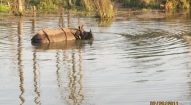
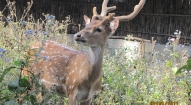
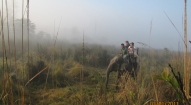
The itineraries and activities of the Chitwan and the Bardia national parks are almost similar in character, but activities may vary between seasons. The number and course of your safari activities are determined by the number of nights you book for. Two nights - three days programs could include activities like Elephant back safari, jungle walk, bird watching, dugout canoe rides on the river. In the evening a cultural show of the traditional Terai dances are a must. Following is an purpose itinerary for the Chitwan National Park Safari Program which, on request can be customized easily; depending on your interest, specific requirement and the availability of time.
Tentative Itinerary for Chitwan National Park Jungle Safari:
Day 01
• ----- Arrival and welcome
• ----- Briefing by the Lodge manager
• 1300 Lunch
• 1530 Elephant ride/nature walk/visit to observation tower
• 1830 Slide show/Tharu stick dance
• 1900 Dinner
Day 02
• 0530 Wakeup call
• 0545 Tea/Coffee
• 0600 Elephant ride/bird watching
• 0800 Breakfast
• 0900 Canoe ride/elephant briefing / swimming and bath
• 1300 Lunch
• 1500 Elephant ride / nature walk / visit to observation tower / Canoe ride
• 1830 Tharu Stick Dance/slide show
• 1930 Dinner
Day 03
• 0530 Wakeup call
• 0545 Tea/Coffee
• 0600 Bird watching/elephant ride
• 0800 Breakfast
• 0900 Elephant briefing/swimming and bath/Canoe ride
• 1300 Lunch
• 1530 Jungle drive/elephant ride/Canoe ride
• 1830 Slide show/Tharu stick dance
• 1900 Dinner
Day 04
• ----- Morning free for packing.
• 8:00 Breakfast
• 9:00 Departure from the lodge

